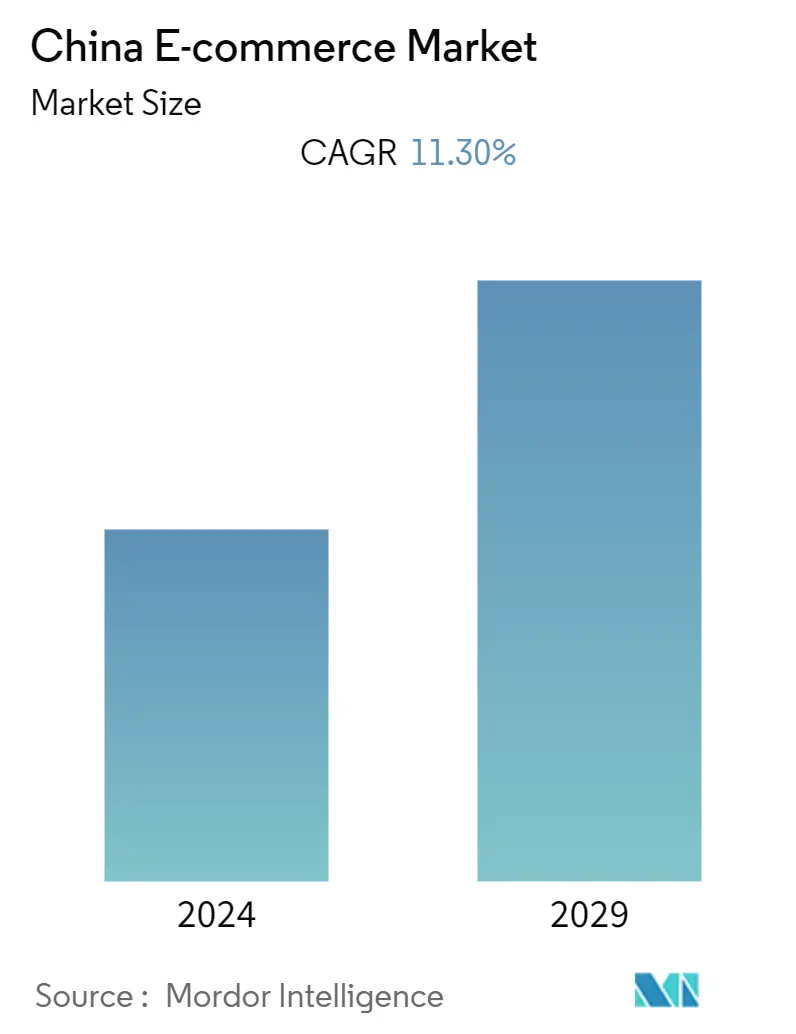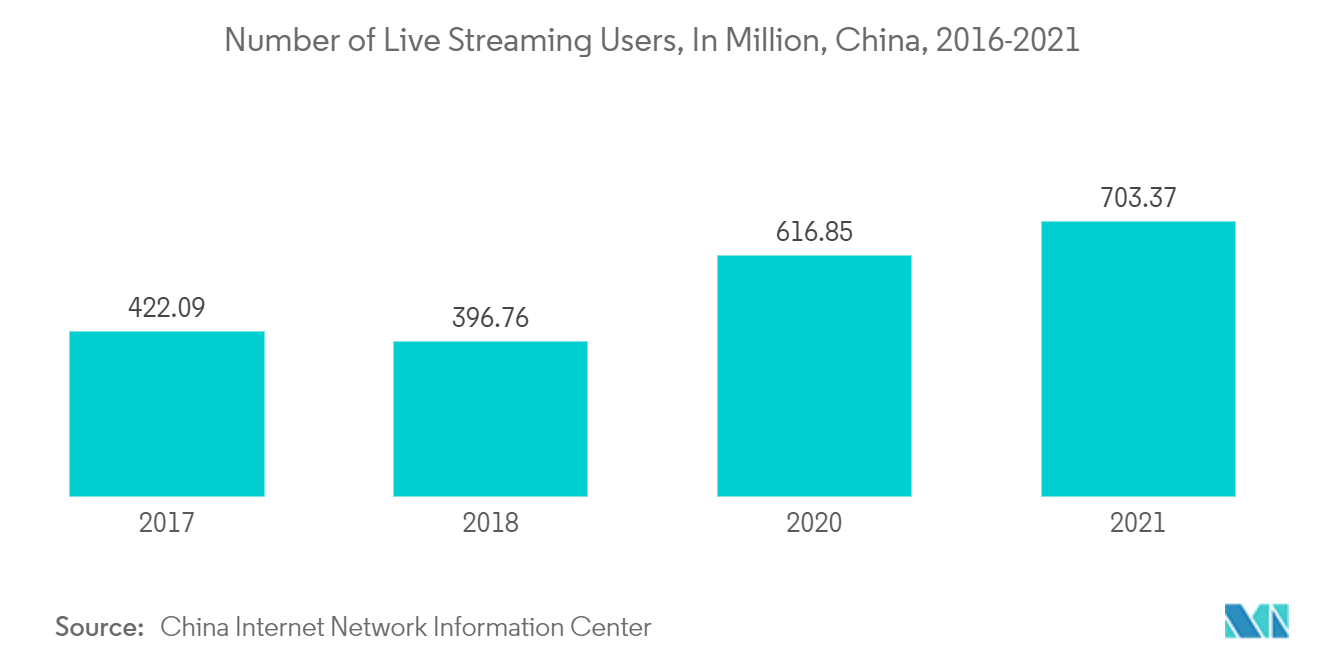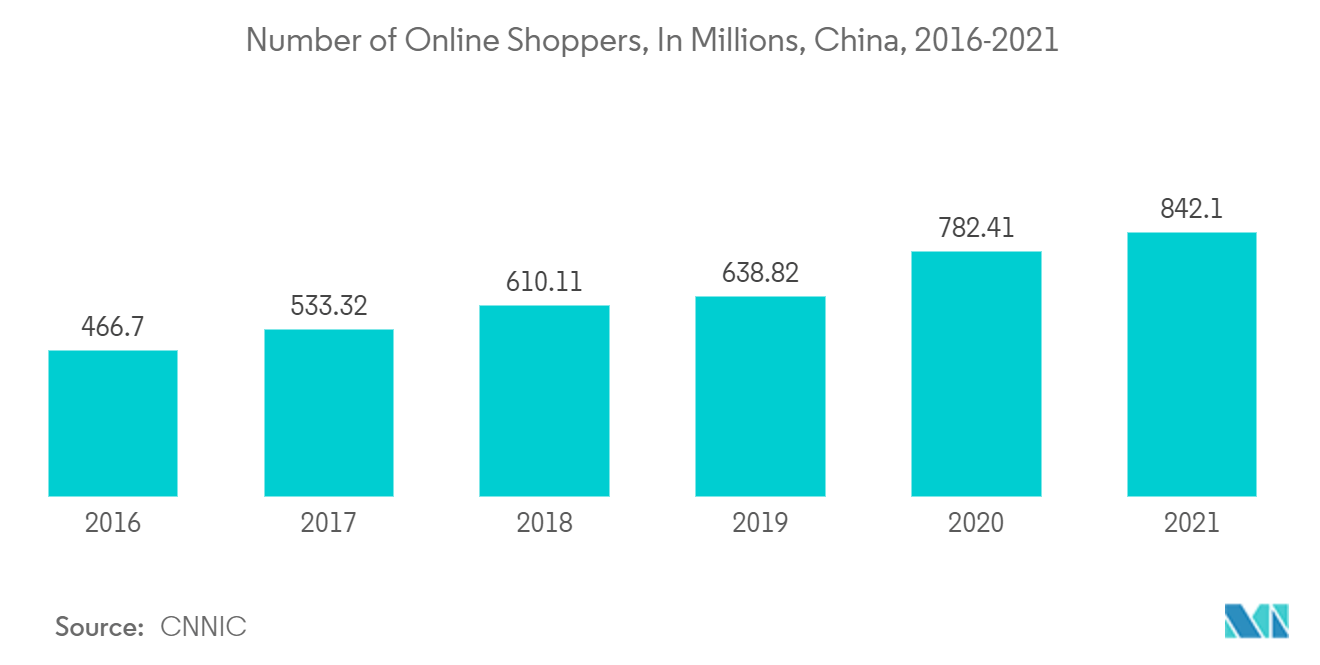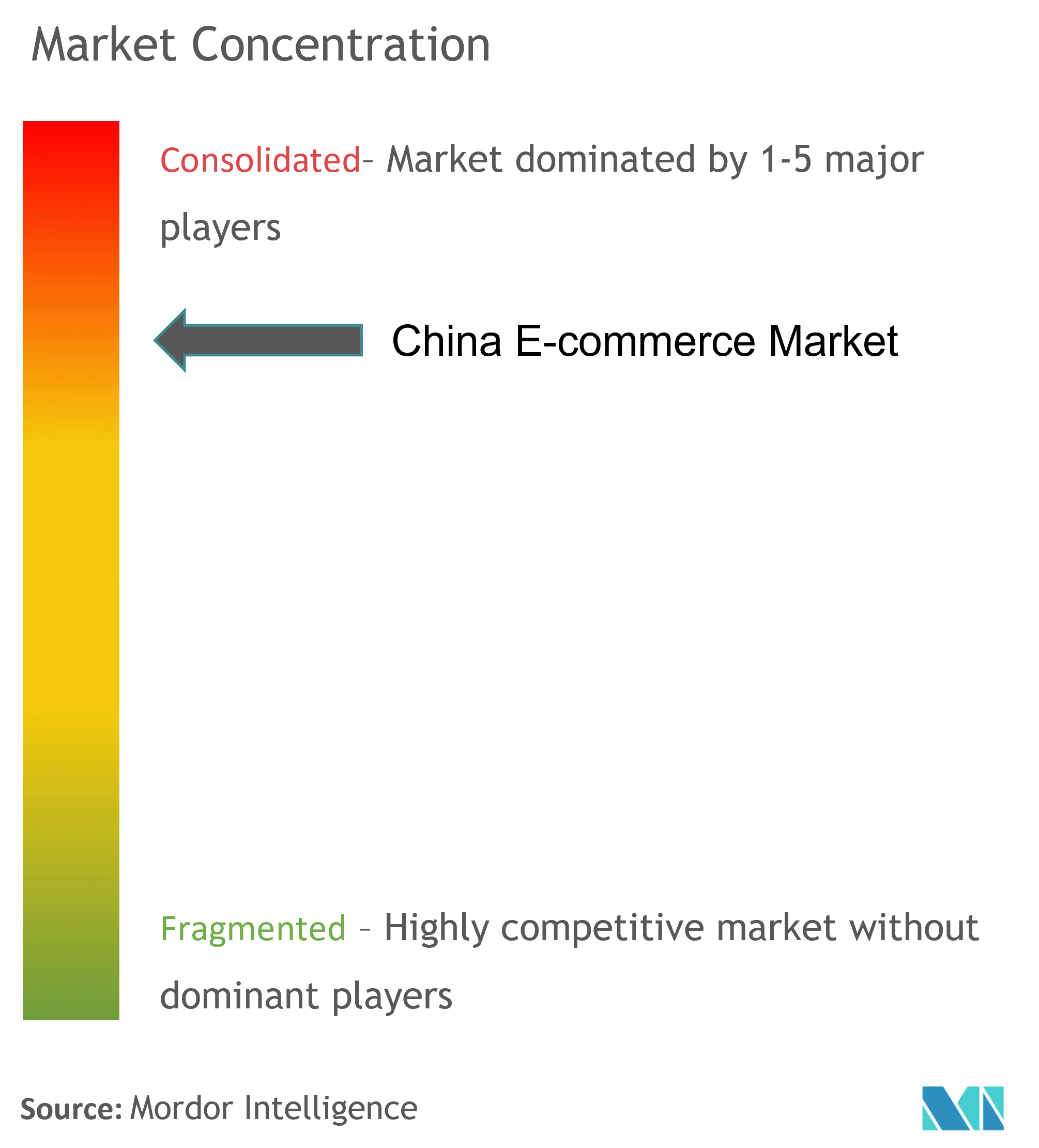China E-Commerce Market Size

| Study Period | 2019 - 2029 |
| Base Year For Estimation | 2023 |
| Forecast Data Period | 2024 - 2029 |
| Historical Data Period | 2019 - 2022 |
| CAGR (2024 - 2029) | 11.30 % |
| Market Concentration | High |
Major Players
*Disclaimer: Major Players sorted in no particular order |
Need a report that reflects how COVID-19 has impacted this market and its growth?
China E-Commerce Market Analysis
The China E-commerce Market is expected to register a CAGR of 11.30% during the forecast period.
The primary factors driving the growth of the E-commerce market in the region are smartphone-driven M-commerce culture, innovative digital payments systems, and rising live -commerce platforms, among others.
- With a vast population, the Chinese E-commerce market is the world's largest E-commerce market. Chinese E-commerce market evolved rapidly during the past few years, primarily driven by high internet and smartphone penetration, increasing consumer confidence in online shopping, the emergence of e-commerce platforms, and the availability of various alternative payment solutions.
- Alternative payment solutions were the primary beneficiary of rising e-commerce purchases. Payment solutions such as Alipay and WeChat Pay are rapidly growing as payment solutions for E-commerce platforms. While Alipay benefits as a primary payment tool on all the e-commerce platforms owned by the Alibaba group, WeChat Pay, which is offered by Tencent, leverages its massive social media user base to push online payments. As Chinese customers continue to embrace e-commerce, these payment solutions are further expected to gain momentum.
- Furthermore, an inconvenient and often confrontational in-person shopping culture helped motivate shoppers in the region to embrace the straightforward reliability of E-commerce platforms, mainly the ease it offered in various shopping activities for making returns and securing refunds for online orders. Moreover, the supply of low-cost delivery services provided by China's millions of migrant laborers enabled companies like JD.com and AlibabaGroup to provide same-day delivery anywhere in the country.
- However, stringent rules and regulations related to local E-commerce law and Intellectual Property Enforcement for E-commerce platforms can create problems for E-commerce companies which can hamper the market's growth. For instance, the E-Commerce Law in China is designed to address rampant online infringement of intellectual property rights. The law included requirements related to notice-and-takedown mechanisms for the region's e-commerce platforms. The notice-and-takedown tools allow individuals to request that platforms take down links offering products that infringe on established IP rights. As different E-commerce platforms have varying procedures for accepting takedown notices, E-commerce companies in the region must familiarize themselves with takedown procedures for various e-commerce platforms.
- The COVID-19 outbreak has further driven e-commerce activities in China, as concerned consumers are increasingly using the online channel for their purchases to avoid getting exposed to the disease. Although the COVID-19 pandemic decreased overall consumer spending, it has resulted in growth in e-commerce purchases. While sectors such as travel and restaurant services were affected due to lockdown across the country, strong growth is seen in online purchases of groceries and physical goods.
China E-Commerce Market Trends
Livestream E-commerce to drive the Market
- Livestreaming is a very popular form of E-commerce in China where Key Opinion Leaders conduct live video broadcasts of themselves while they market different goods and products to their audiences. The pandemic has led to the rapid advancement and adoption of live streaming in the E-commerce market in the region.
- The most significant advantage of live streaming E-commerce is its ability to reach a large number of people spread throughout the country, especially those outside of major cities. By targeting live streams to more rural areas and lower-tier cities, companies can increase brand awareness and expand their audience to all parts of China.
- Many E-commerce giants like Alibaba's Taobao, JD.com, and newer competitors from the entertainment side like Douyin and Kuaishou, are promoting E-commerce products live via digital video in the region. Live commerce quickly established itself as a fixture in sales campaigns for Singles' Day, a major shopping event in China, as a reliable digital tool for driving customer engagement and E-commerce sales.
- Moreover, as reported by the China Internet Network Information Center, the number of online streaming users is rapidly increasing in China. For instance, the number of online streamers rose from 344.31 million in 2016 to 703.37 million users in 2021. Furthermore, live commerce increases a brand's appeal and distinctiveness and attracts additional consumers. It can strengthen the positioning of E-commerce among existing customers and attract new ones, especially young people keen on innovative shopping formats and experiences.
- All of the aforementioned factors are further expected to boost the growth of the E-commerce Market in the region.

Growing Penetration of Online Shoppers to Boost the E-commerce Market
- The rising popularity of online shopping resulted in an increase in the number of online shoppers in the region, supported by high mobile internet penetration and the accessibility and speed of the internet in China. For instance, as reported by the China Internet Network Information Center, the number of online shoppers rose from 466.7 million in 2016 to 842.1 million in 2021. The rapid increase in online shoppers is further expected to boost E-commerce sales in the region.
- Along with this, the online shopping penetration increased in the region, supported by the rise of smartphone-driven M-commerce and innovative digital payment solutions offered by various market players in the area. For instance, the China Internet Network Information Center reported that the online shopping penetration was 60% in 2015, which grew to 81.6% in 2021.
- Furthermore, the Singles Day shopping event in China, November 11th or 11/11, is the busiest online shopping day of the year. Brands offer discounts and potentially generate a significant percentage of their annual revenue. This type of event further attracts consumers to shop online, which results in an increase in the number of online shoppers driving the E-commerce market in the country.
- Moreover, as a result of growing online shoppers, the E-commerce share of total retail sales in consumer goods has rapidly increased over the past few years in the region. For instance, as reported by the National Bureau of Statistics of China, the E-commerce share of total retail sales in consumer goods in China was 10.8% in 2015, which increased dramatically to 24.5% in 2021 with a massive increase of 13.7%. All of the factors mentioned above further accelerate the growth of the E-commerce market in the region.

China E-Commerce Industry Overview
The China E-commerce market is consolidated with the presence of major players such as Alibaba Group, JD.com, Pinduoduo Inc, among others. These market players hold a significant share in the China E-commerce market. The companies in the region are increasing their presence in the market by introducing new payment systems and entering into strategic partnerships or acquisitions.
- November 2021 - Chinese mobile payment services provider Yeahka Limited announced that it had agreed to invest USD 15.6 million into Qianqianhui, a provider of in-store e-commerce services in China. In exchange, Yeahka Limited will receive 60% of Qinqinhui's enlarged share capital from the company's parent, Dingding Cultural Tourism Co. Ltd. The investment in Qianqianhui is part of Yeahka's accelerating move into in-store e-commerce services.
- March 2022 - Chinese E-commerce company JD.com announced to acquire Deppon Logistics for USD 1.42 billion. The acquisition of Deppon Logistics will expand JD Logistics' capability amid the E-commerce boom resulting from the lockdown measures intended to curb the pandemic.
China E-Commerce Market Leaders
JD.com
Pinduoduo Inc
Suning.com
Alibaba Group
Vipshop Holdings Ltd
*Disclaimer: Major Players sorted in no particular order

China E-Commerce Market News
- January 2022 - Major Chinese E-commerce company JD.com formed a strategic partnership with Ottawa-based Shopify to help global brands tap China's enormous appetite for imported goods and help Chinese merchants sell overseas. JD.com promises to simplify access and compliance for Chinese brands and merchants looking to reach consumers in Western markets through the partnership.
- April 2022 - SavMobi Technology, Inc., a Nevada corporation, signed a Memorandum of Understanding with Dalian Yuanmeng Media Co., Ltd, a company registered under the laws of the People's Republic of China. Under the MOU, Yuanmeng agreed to provide their client base to collaborate with SVMB to explore China's E-commerce market. The income sharing ratio will be fifty-fifty between both companies. The Company is currently operating in the provision of commercial mobile technical support services in China.
China E-Commerce Market Report - Table of Contents
1. INTRODUCTION
1.1 Study Assumptions and Market Defination
1.2 Scope of the Study
2. RESEARCH METHODOLOGY
3. EXECUTIVE SUMMARY
4. MARKET INSIGHTS
4.1 Market Overview
4.2 Industry Attractiveness - Porter's Five Forces Analysis
4.2.1 Bargaining Power of Suppliers
4.2.2 Bargaining Power of Buyers/Consumers
4.2.3 Threat of New Entrants
4.2.4 Threat of Substitute Products
4.2.5 Intensity of Competitive Rivalry
4.3 Key Market Trends and Share of E-commerce of Total Retail Sector
4.4 Impact of COVID-19 on the E-commerce Sales
5. MARKET DYNAMICS
5.1 Market Drivers
5.1.1 Livestream E-commerce to drive the Market
5.1.2 Growing Penetration of Online Shoppers to Boost the E-commerce Market
5.2 Market Challenges
5.2.1 Challenges Related to Local E-commerce Law and Intellectual Property Enforcement
5.3 Analysis of Key Demographic Trends and Patterns Related to E-commerce Industry in China (Coverage to Include Population, Internet Penetration, E-commerce Penetration, Age & Income etc.)
5.4 Analysis of the Key Modes of Transaction in the E-commerce Industry in China (Coverage to Include Prevalent Modes of Payment Such as Cash, Card, Bank Transfer, Wallets, etc.)
5.5 Analysis of Cross-Border E-commerce Industry in China (Current Market Value of Cross-border & Key Trends)
5.6 Current Positioning of China in the E-commerce Industry in Asia Pacific
6. MARKET SEGMENTATION
6.1 By B2C E-commerce
6.1.1 Market Size (GMV) for the Period of 2017-2027
6.1.2 Market Segmentation - by Application
6.1.2.1 Beauty and Personal Care
6.1.2.2 Consumer Electronics
6.1.2.3 Fashion and Apparel
6.1.2.4 Food and Beverages
6.1.2.5 Furniture and Home
6.1.2.6 Others (Toys, DIY, Media, etc.)
6.2 By B2B E-commerce
6.2.1 Market Size for the Period of 2017-2027
7. COMPETITIVE LANDSCAPE
7.1 Company Profiles
7.1.1 JD.com
7.1.2 Alibaba.com
7.1.3 Pinduoduo Inc
7.1.4 Suning.com
7.1.5 Vipshop Holdings Ltd
7.1.6 Xiaohongshu (Little Red Book)
7.1.7 JuMei.com
7.1.8 Yihaodian
7.1.9 Dangdang Inc.
7.1.10 Mogujie
- *List Not Exhaustive
8. Investment Analysis
9. Future Outlook of the Market
China E-Commerce Industry Segmentation
E-commerce refers to any form of business transaction conducted online or over the internet. The most common example of E-commerce is online shopping, which is defined as buying and selling goods or services via the internet on any device.
The China E-commerce Market is Segmented into B2C E-commerce (Beauty and Personal Care, Consumer Electronics, Fashion and Apparel, Food and Beverage, Furniture and Home), and B2B E-commerce.
| By B2C E-commerce | ||||||||
| Market Size (GMV) for the Period of 2017-2027 | ||||||||
|
| By B2B E-commerce | |
| Market Size for the Period of 2017-2027 |
China E-Commerce Market Research FAQs
What is the current China E-commerce Market size?
The China E-commerce Market is projected to register a CAGR of 11.30% during the forecast period (2024-2029)
Who are the key players in China E-commerce Market?
JD.com, Pinduoduo Inc, Suning.com, Alibaba Group and Vipshop Holdings Ltd are the major companies operating in the China E-commerce Market.
What years does this China E-commerce Market cover?
The report covers the China E-commerce Market historical market size for years: 2019, 2020, 2021, 2022 and 2023. The report also forecasts the China E-commerce Market size for years: 2024, 2025, 2026, 2027, 2028 and 2029.
How is mobile commerce influencing the China E-Commerce Market?
Mobile commerce and rising live commerce are significantly driving market growth due to their convenience and the ubiquity of smartphones.
E-Commerce in China Industry Report
The China e-commerce market is witnessing remarkable growth, propelled by a surge in mobile commerce, innovative digital payments, and live e-commerce platforms. This expansion is bolstered by high internet and smartphone usage, growing consumer trust in online shopping, and the advent of diverse e-commerce platforms with various payment options. Segmented into B2B and B2C models, the market caters to a wide range of needs, from business exchanges to consumer retail in beauty, fashion, and electronics. Major players dominate the market, employing strategic partnerships and new payment systems to solidify their positions. Live streaming e-commerce and an increasing number of online shoppers, driven by mobile internet access and digital payment convenience, are significantly boosting sales. However, the market navigates challenges posed by local e-commerce laws and intellectual property enforcement. Despite these hurdles, the China e-commerce market's trajectory remains upward, driven by technological advancements and evolving consumer behaviors. For detailed statistics and analysis on market share, size, and revenue growth, refer to Mordor Intelligence™ Industry Reports, offering a comprehensive market forecast and historical overview, available as a free report PDF download.
